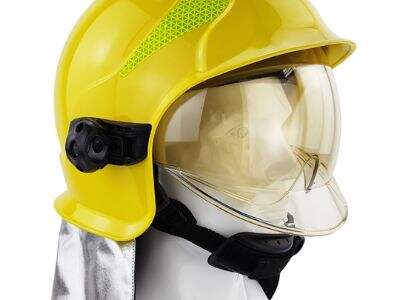The Role of Fire Helmet Material in Safety
The performance of fire helmets depends on the materials they are made from. Fiberglass and polyetherimide are strong, yet lightweight materials that provide durable head protection, and an excellent defense against halogen headlamp bulbs and low-speed impacts. About the materials of the helmet are selected as these appropriate to ensure its stability over time, and its resistance to heat, yet characteristics that do not meet a helmet of a firefighter. Thanks to the use of materials such as fiberglass and polyetherimide, firefighters can feel confident that their helmets protect them when it matters.
Advantages of fiberglass and Polyetherimide for fire helmet construction
Polyetherimide and fiberglass are among the most common materials used to make fire helmets, and they have some important dissimilarities. Fiberglass - Lightweight material known for its strength and resilience. It can incidence and has excellent resistance to heat. On the contrary, polyetherimide is also a lightweight and strong high-performance plastic. It is remarkably resistant to heat, and can stand up to high-heat applications well without losing its form or becoming weakened. Both have special properties that lend themselves to the fabrication of fire helmets.
Decoding the Durability and Heat Resistance of Fire Helmet Materials
The fire helmet material should have physical and heat resistance properties. Firefighters need helmets to match the extreme conditions they fight on the job. Also, although the fiberglass material will hold up under heavy use for a good length of time. It is also heat-resistant, helping protect firefighters from intense heat. The polyetherimide is also strong and heat-resistant, with the ability to withstand high temperatures without melting or deforming. These properties make both fiberglass and polyetherimide a good choice for a fire helmet construction.
How Fiberglass and Polyetherimide Keep Firefighters Safe in Dangerous Situations
rdbr:Look for the Special Operations fire fighters deal with hazardous situations on a regular basis, and they must have the protective gear they ca na rely on. Fiberglass and polyetherimide are highly beneficial to firefighters in such situations. Fiberglass helmets are lightweight and comfortable so that firefighters are able to make their way through emergencies as easily as possible. They also offer robust protection against impact and heat, helping protect firefighters from falling debris and flames. The same benefits will be realized with polyetherimide helmets without concern for heat resistance. This is what keeps firefighters safe in blazing temperatures and raging fires. Fiberglass and polyetherimide are developed to protect firefighters performing their duties in hazard conditions.
The role of material choice in fire helmet design and performance perspective
Material selection is a determinative factor in the design and performance of fire helmets. The right products can greatly impact a firefighter’s safety and comfort. Glass fiber and polyetherimide are used because of their special characteristics to make fire helmets high quality. These fabrics have been tested and have been found to outperform the high standards required of the firefighting gear. For example, by using fiberglass and polyetherimide, fire helmet makers are able to produce helmets that provide better protection, are more durable, and are more resistant to heat. This ensures that firefighters have the best equipment possible to help keep them safe as they work.
In conclusion, air breathing apparatus the materials of the fire helmet, e.g. the fiberglass and polyetherimide, are very important in protecting the safety and health of fire fighter. These fabrics supply high strength, durability, and heat resistance, which are key attributes for protecting firefighters during high-risk operations. Firefighters have also become more aware of the capabilities and advantages of such materials as fiberglass, and polyetherimide allowing them to trust that their helmets will offer the required level of protection in emergencies. anben has been committed to develop the fire helmet product utilizing the top material to keep fireman in the safest condition witheffectiveness during emergent call.
Table of Contents
- The Role of Fire Helmet Material in Safety
- Advantages of fiberglass and Polyetherimide for fire helmet construction
- Decoding the Durability and Heat Resistance of Fire Helmet Materials
- How Fiberglass and Polyetherimide Keep Firefighters Safe in Dangerous Situations
- The role of material choice in fire helmet design and performance perspective

 EN
EN
 AR
AR
 BG
BG
 DA
DA
 NL
NL
 FR
FR
 DE
DE
 HI
HI
 IT
IT
 JA
JA
 KO
KO
 NO
NO
 PL
PL
 PT
PT
 RO
RO
 RU
RU
 ES
ES
 SV
SV
 TL
TL
 ID
ID
 SK
SK
 SL
SL
 UK
UK
 VI
VI
 TH
TH
 TR
TR
 MS
MS
 BE
BE
 HY
HY
 AZ
AZ
 KA
KA
 BN
BN
 BS
BS
 EO
EO
 JW
JW
 LO
LO
 MN
MN
 NE
NE
 MY
MY
 KK
KK

